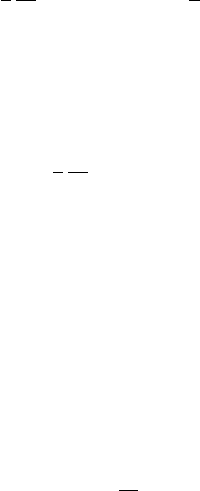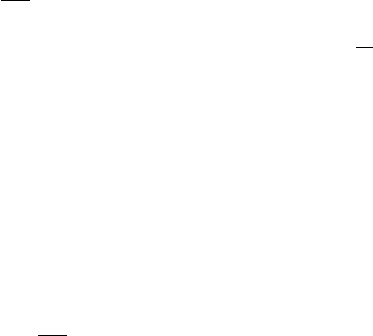Taylor M.E. Partial Differential Equations III: Nonlinear Equations
Подождите немного. Документ загружается.


578 17. Euler and Navier–Stokes Equations for Incompressible Fluids
for t 2 .0; 1.Wetake
(5.22) Y D W
0
:
As ke
tA
k
L.W
0
;W
s
/
Ct
s=2
for t 1, the condition (5.21) requires s 2 .0; 2/,
in (5.18). We need to verify (5.19). Note that, by Proposition 5.2 and interpolation,
(5.23) W
s
H
s
.; T /; for 0 s 2:
Thus (5.19) will hold provided
(5.24) M W H
s
.; T / ! H
1
.; T ˝ T/; with M.u/ D u ˝u:
Lemma 5.3. Provided dim 5, there exists s
0
<2such that (5.24) holds for
all s>s
0
.
Proof. If dim M D n, one has
H
n=2C"
H
n=2C"
H
n=2C"
and H
n=4
H
n=4
H
0
D L
2
;
the latter because H
n=4
L
4
. Other inclusions
(5.25) H
r
H
r
H
;rD
n
4
C
2
C "; D
1
2
n C "
;
follow by a straightforward interpolation. One sees that (5.24) holds for s>s
0
with
(5.26) s
0
D
n
4
C
1
2
. if n 2/:
For 2 n 5; s
0
increases from 1 to 7=4;forn D 6; s
0
D 2.
Thus we have an existence result:
Proposition 5.4. Suppose dim 5.Ifs
0
is given by (5.26) and u
0
2 W
s
for
some s 2 .s
0
;2/, then there exists T>0such that (5.17) has a unique solution
(5.27) u 2 C
Œ0; T ; W
s
:
We can extend the last result a bit once the following is established:
Proposition 5.5. Set V
s
D V
0
\ H
s
.; T /,for0 s 1. We have
(5.28) W
s
D V
s
; for 0 s<
1
2
;

5. Viscous flows on bounded regions 579
and hence
(5.29) P W H
s
.; T / ! W
s
;
for such s.
Proof. To deduce (5.29) from (5.28), note that, by (3.5), P W H
s
.; T / !
H
s
.; T / for s D 0; 1, hence, by interpolation, for all s 2 Œ0; 1,soP W
H
s
.; T / ! V
s
,fors 2 Œ0; 1.
To establish (5.28), recall that W
1
D D.A
1=2
/ D V
0
\ H
1
0
.; T /. We hence
have
W
s
D ŒV
0
;V
0
\ H
1
0
.; T /
s
; for 0 s 1:
Thus (5.28) will follow from the identity
(5.30) ŒV
0
;V
0
\ H
1
0
.; T /
s
D V
0
\ ŒL
2
.; T /; H
1
0
.; T /
s
;0 s 1;
since, as seen in (5.37) of Chap. 4,
(5.31) ŒL
2
./; H
1
0
./
s
D H
s
./; for 0 s<
1
2
:
Following [FM], we make use of the following result to establish (5.30):
Lemma 5.6. There is a continuous projection Q from L
2
.; T / onto V
0
such
that Q maps H
2
.; T / \ H
1
0
.; T / D D./ to H
2
.; T / \ W
1
D D.A/.
Here is the Laplace operator on , with Dirichlet boundary condition. We
know that
(5.32) ŒL
2
.; T /; H
2
.; T / \ H
1
0
.; T /
1=2
D D
./
1=2
D H
1
0
.; T /;
so the lemma implies that the projection Q has the property
(5.33) Q W H
1
0
.; T / ! W
1
D V
0
\ H
1
0
.; T /;
and (5.30) is a straightforward consequence of this result.
Proof of lemma. We define the continuous operator Q
0
W D./ ! D.A/ by
(5.34) Q
0
u DA
1
Pu; u 2 D./:
Since Q
0
u D u for u 2 D.A/ D D./ \ V
0
and since D.A/ is dense in V
0
,it
suffices to show that Q
0
can be extended to a bounded operator from L
2
.; T / to
V
0
. Indeed, by the self-adjointness of A and , we have, for the adjoint, mapping
V
0
to L
2
.; T /,

580 17. Euler and Navier–Stokes Equations for Incompressible Fluids
(5.35) Q
0
DA
1
;W V
0
,! L
2
.; T /;
which is a bounded operator from V
0
to L
2
.; T /, since the inclusion maps
D.A/ into D./. This proves the lemma, so Proposition 5.5 is established.
We now return to the integral equation (5.17), replacing Y D W
0
in (5.22)by
(5.36) Y D W
D V
;2
h
0;
1
2
:
We take X D W
s
,asin(5.18), and this time we need s 2 .0; 2/ in order for
(5.21) to hold with <1. Higher regularity for the Stokes operator gives
(5.37) W
s
H
s
.; T /; for s 2 R
C
;
extending (5.23). Thus (5.19) will hold provided we extend (5.24)to
(5.38) M W H
s
.; T / ! H
1C
.; T ˝ T/; M.u/ D u ˝ u:
Let us write
D
1
2
ı; s D 2 C ı D
5
2
2ı:
By the arguments used in Lemma 5.3, we have the following:
Lemma 5.7. Provided dim 6,ifı 2 .0; 1=2/ is small enough, and D
1=2 ı, there exists s
0
2 .; 2 C / such that (5.38) holds for all s>s
0
.
Proof. If n 4,thenH
s
./ is an algebra for s D 5=2 2ı if ı is small enough.
If n 5, we can take s
0
D .n C 3/=4.
Thus we have the following complement to Proposition 5.4:
Proposition 5.8. Suppose dim 6.Ifı>0is small enough, s D 5=2 2ı,
and u
0
2 W
s
, then there exists T>0such that (5.17) has a unique solution in
C
Œ0; T ; W
s
.
There are results on higher regularity of strong solutions, for 0<t<T.We
refer to [Tem3] for a discussion of this.
Having treated strong solutions, we next establish the Hopf theorem on the
global existence of weak solutions to the Navier–Stokes equations, in the case of
domains with boundary.
Theorem 5.9. Assume dim 3. Given u
0
2 W
0
; > 0, the system (5.1)–(5.3)
has a weak solution for t 2 .0; 1/,
(5.39) u 2 L
1
.R
C
;W
0
/ \ L
2
loc
.R
C
;W
1
/:

5. Viscous flows on bounded regions 581
The proof is basically parallel to that of Theorem 4.6. We sketch the argument.
As above, we assume for simplicity that is Ricci flat. We have the Stokes oper-
ator A, a self-adjoint operator on W
0
,definedby(5.12)–(5.13). As in the proof of
Theorem 4.6, we consider the family of projections J
"
D ."A/,where./ is
the characteristic function of Œ1; 1. We approximate the solution u by u
"
, solving
(5.40)
@u
"
@t
C J
"
P div.u
"
˝ u
"
/ DAu
"
; u
"
.0/ D J
"
u
0
:
This has a global solution, u
"
2 C
1
Œ0; 1/; Range J
"
.Asin(4.32), fu
"
g is
bounded in L
1
.R
C
;L
2
.//. Also, as in (4.33),
(5.41) 2
Z
T
0
kru
"
.t/k
2
L
2
dt DkJ
"
u
0
k
2
L
2
ku
"
.T /k
2
L
2
;
for each T 2 R
C
. Thus, parallel to (4.34), for any bounded interval I D Œ0; T ,
(5.42) fu
"
g is bounded in L
2
.I; W
1
/:
Instead of paralleling (4.36)–(4.39), we prefer to use (5.42) to write
(5.43) fr
u
"
u
"
g bounded in L
1
I;L
3=2
./
;
provided dim 3. In such a case, we also have
P W W
1
! H
1
./ L
3
./;
and hence
(5.44) P W L
3=2
./ ! .W
1
/
:
Also fJ
"
g is uniformly bounded on W
1
and its dual .W
1
/
,andA W W
1
!
.W
1
/
. Thus, in place of (4.37), we have
(5.45) f@
t
u
"
g bounded in L
1
.I; .W
1
/
/;
so
(5.46) fu
"
g is bounded in H
s
.I; .W
1
/
/; 8 s 2
0;
1
2
:
Now we interpolate this with (5.42), to get, for all ı>0,
(5.47) fu
"
g bounded in H
s
.I; H
1ı
.//; s D s.ı/ > 0;

582 17. Euler and Navier–Stokes Equations for Incompressible Fluids
hence, parallel to (4.40),
(5.48) fu
"
g is compact in L
2
.I; H
1ı
.//; 8 ı>0:
The rest of the argument follows as in the proof of Theorem 4.6.
We also have results parallel to Propositions 4.9–4.10:
Proposition 5.10. Let u
1
and u
2
be weak solutions to (5.11), satisfying
(5.49) u
j
2 L
1
.I; W
0
/ \ L
2
.I; W
1
/; u
j
2 L
4
.I /:
Suppose dim D 2 or 3;ifdim D 3, suppose furthermore that
(5.50) u
1
2 L
8
I;L
4
./
:
If u
1
.0/ D u
2
.0/,thenu
1
D u
2
on I .
The proof of both this result and the following are by the same arguments as
used in 4.
Proposition 5.11. If u is a Leray–Hopf solution and I D Œ0; T ,then
(5.51) u 2 L
4
.I / if dim D 2
and
(5.52) u 2 L
8=3
I;L
4
./
if dim D 3:
Thus we have uniqueness of Leray–Hopf solutions if dim D 2. The follow-
ing result yields extra smoothness if u
0
2 W
1
:
Proposition 5.12. If dim D 2, and u is a Leray–Hopf solution to the Navier–
Stokes equations, with u.0/ D u
0
2 W
1
, then, for any I D Œ0; T ; T < 1,
u 2 L
1
.I; W
1
/ \ L
2
.I; W
2
/;(5.53)
and
(5.54)
@u
@t
2 L
2
.I; W
0
/:
Proof. Let u
j
be the approximate solution u
"
defined by (5.40), with " D "
j
! 0.
We have
(5.55)
1
2
d
dt
A
1=2
u
j
.t/
2
L
2
C kAu
j
.t/k
2
L
2
D
r
u
j
u
j
;Au
j
L
2
;

5. Viscous flows on bounded regions 583
upon taking the inner product of (5.40) with Au
"
. Now there is the estimate
(5.56)
ˇ
ˇ
r
u
j
u
j
;Au
j
ˇ
ˇ
C kru
j
k
3
L
3
:
To see this, note that since d ı .I P/ D 0,wehave,foru 2 W
2
,
.r
u
u; u/
V
1
D .d r
u
u;du/ D
Œd; r
u
u;du
C
1
2
Œr
u
Cr
u
du;du
;
and the absolute value of each of the last two terms is easily bounded by
R
jruj
3
dV .
In order to estimate the right side of (5.56), we use the Sobolev imbedding
result
(5.57) H
1=3
./ L
3
./; dim D 2;
which implies kvk
L
3
C kvk
2=3
L
2
kvk
1=3
H
1
,so
(5.58)
kru
j
k
3
L
3
C kru
j
k
2
L
2
kru
j
k
H
1
C
0
.ı/
1
kru
j
k
4
L
2
C C
0
ıkru
j
k
2
H
1
:
We have kru
j
k
2
H
1
C kAu
j
k
2
L
2
CC ku
j
k
2
L
2
, by Proposition 5.2,soifı is picked
small enough, we can absorb the kru
j
k
2
H
1
-term into the left side of (5.55). We
get
(5.59)
1
2
d
dt
A
1=2
u
j
.t/
2
L
2
C
2
kAu
j
.t/k
2
L
2
C kA
1=2
u
j
.t/k
4
L
2
C C
ku
j
.t/k
4
L
2
Cku
j
.t/k
2
L
2
:
We want to apply Gronwall’s inequality. It is convenient to set
(5.60)
j
.t/ D
A
1=2
u
j
.t/
2
L
2
;ˆ./D
4
C
2
:
The boundedness of u
"
in L
2
loc
.R
C
;W
1
/ (noted in (5.42)) implies that, for any
T<1,
(5.61)
Z
T
0
j
.t/ dt K.T / < 1;
with K.T / independent of j . If we drop the term .=2/kAu
j
.t/k
2
L
2
from (5.59),
we obtain
(5.62)
d
dt
A
1=2
u
j
.t/
2
L
2
C
j
.t/
A
1=2
u
j
.t/
2
L
2
C Cˆ
ku
j
.t/k
L
2
;

584 17. Euler and Navier–Stokes Equations for Incompressible Fluids
and Gronwall’s inequality yields
(5.63)
A
1=2
u
j
.t/
2
L
2
e
CK.t/
A
1=2
u
0
2
L
2
CCe
CK.t/
Z
t
0
ˆ
ku
j
.s/k
L
2
ds:
This implies that u
j
is bounded in L
1
.I; W
1
/, and then integrating (5.59) implies
u
j
is bounded in L
2
.I; W
2
/. The conclusions (5.53)and(5.54) follow.
The argument used to prove Proposition 5.12 does not extend to the case in
which dim D 3.Infact,ifdim D 3,then(5.57) must be replaced by
(5.64) H
1=2
./ L
3
./; dim D 3;
which implies kvk
L
3
C kvk
1=2
L
2
kvk
1=2
H
1
, and hence (5.58) is replaced by
(5.65)
kru
j
k
3
L
3
C kru
j
k
3=2
L
2
kru
j
k
3=2
H
1
C.ı/
3
kru
j
k
6
L
2
C Cıkru
j
k
2
H
1
:
Unfortunately, the power 6 of kru
j
k
L
2
on the right side of (5.65)istoolargein
this case for an analogue of (5.60)–(5.63) to work, so such an approach fails if
dim D 3.
On the other hand, when dim D 3, we do have the inequality
(5.66)
1
2
d
dt
kA
1=2
u
j
.t/k
2
L
2
C
2
kAu
j
.t/k
2
L
2
C kA
1=2
u
j
.t/k
6
L
2
C C
ku
j
.t/k
6
L
2
Cku
j
.t/k
2
L
2
:
We have an estimate ku
j
.t/k
L
2
K, so we can apply Gronwall’s inequality to
the differential inequality
1
2
d
dt
Y
j
.t/ CY
j
.t/
3
C C.K
6
C K
2
/
to get a uniform bound on Y
j
.t/ DkA
1=2
u
j
.t/k
2
L
2
, at least on some interval
Œ0; T
0
. Thus we have the following result.
Proposition 5.13. If dim D 3, and u is a Leray–Hopf solution to the Navier–
Stokes equations, with u.0/ D u
0
2 W
1
, then there exists T
0
D T
0
.ku
0
k
W
1
/>0
such that
(5.67) u 2 L
1
Œ0; T
0
; W
1
\ L
2
Œ0; T
0
; W
2
;
and
(5.68)
@u
@t
2 L
2
Œ0; T
0
; W
0
:

Exercises 585
Note that the properties of the solution u on Œ0; T
0
in (5.67) are stronger
than the properties (5.49)–(5.50) required for uniqueness in Proposition 5.10.
Hence we have the following:
Corollary 5.14. If dim D 3 and u
1
and u
2
are Leray–Hopf solutions to the
Navier–Stokes equations, with u
0
.0/ D u
2
.0/ D u
0
2 W
1
, then there exists
T
0
D T
0
.ku
0
k
W
1
/>0such that u
1
.t/ D u
2
.t/ for 0 t T
0
.
Furthermore, if u
0
2 W
s
with s 2 .s
0
;2/as in Proposition 5.4, then the strong
solution u 2 C.Œ0; T ; W
s
/ provided by Proposition 5.4 agrees with any Leray–
Hopf solution, for 0 t min.T; T
0
/.
As we have seen, a number of results presented in 4 for viscous fluid flows
on domains without boundary extend to the case of domains with boundary. We
now mention some phenomena that differ in the two cases.
The role of the vorticity equation is altered when @ ¤;. One still has the
PDE for w D curl u, for example,
(5.69)
@w
@t
Cr
u
w D w .dim D 2/;
@w
@t
Cr
u
w r
w
u D w .dim D 3/;
but when @ ¤;, the initial value w.0/ alone does not serve to determine w.t/
for t>0from such a PDE, and a good boundary condition to impose on w.t; x/
is not available. This is not a problem in the D 0 case, since u itself is tangent to
the boundary. For >0, one result is that one can have w.0/ D 0 but w.t/ ¤ 0
for t>0. In other words, for >0, interaction of the fluid with the boundary can
create vorticity.
The most crucial effect a boundary has lies in complicating the behavior of
solutions u
in the limit ! 0. There is no analogue of the -independent
estimates of Propositions 4.1 and 4.2 when @ ¤;. This is connected to the
change of boundary condition, from u
j
@
D 0 for positive (however small) to
n uj
@
D 0 when D 0; n being the normal to @. Study of the small- limit
is important because it arises naturally. In many cases flow of air can be modeled
as an incompressible fluid flow with 10
5
. However, after more than a cen-
tury of investigation, this remains an extremely mysterious problem. See the next
section for further discussion of these matters.
Exercises
1. Show that D.A
k
/ H
2k
.; T /,fork 2 Z
C
. Hence establish (5.37).
2. Extend the L
2
-Sobolev space results of this section to L
p
-Sobolev space results.
3. Work out results parallel to those of this section for the Navier–Stokes equations, when
the no-slip boundary condition (5.2) is replaced by the “slip” boundary condition:
(5.70) 2 Def.u/N pN D 0 on @;

586 17. Euler and Navier–Stokes Equations for Incompressible Fluids
where N is a unit normal field to @ and Def.u/ is a tensor field of type .1; 1/,given
by (2.60). Relate (5.70) to the identity
.Lu rp; v/ D2.Def u; Def v/ whenever div v D 0:
6. Vanishing viscosity limits
In this section we consider some classes of solutions to the Navier–Stokes equa-
tions
(6.1)
@u
@t
Cr
u
u
Crp
D u
C F
; div u
D 0;
on a bounded domain, or a compact Riemannian manifold,
(with a flat metric),
with boundary @, satisfying the no-slip boundary condition
(6.2) u
ˇ
ˇ
R
C
@
D 0;
and initial condition
(6.3) u
.0/ D u
0
;
and investigate convergence as ! 0 to the solution to the Euler equation
(6.4)
@u
0
@t
Cr
u
0
u
0
Crp
0
D F
0
; div u
0
D 0;
with boundary condition
(6.5) u
0
k@;
and initial condition as in (6.3). We assume
(6.6) div u
0
; u
0
k@;
but do not assume u
0
D 0 on @.
When @ ¤;, the problem of convergence u
! u
0
is very difficult, and
there are not many positive results, though there is a large literature. The enduring
monograph [Sch] contains a great deal of formal work, much stimulated by ideas
of L. Prandtl. More modern mathematical progress includes a result of [Kt7], that
u
.t/ ! u
0
.t/ in L
2
-norm, uniformly in t 2 Œ0; T , provided one has an estimate
(6.7)
Z
T
0
Z
c
jru
.t; x/j
2
dx dt ! 0; as ! 0;
6. Vanishing viscosity limits 587
where
ı
Dfx 2 W dist.x; @/ ıg. Unfortunately, this condition is not
amenable to checking. In [W] there is a variant, namely that such convergence
holds provided
(6.8)
Z
T
0
Z
./
jr
T
u
.t; x/j
2
dx dt ! 0; as ! 0;
with ./= !1as ! 0,wherer
T
denotes the derivative tangent to @.
Here we confine attention to two classes of examples. The first is the class of
circularly symmetric flows on the disk in 2D. The second is a class of circular
pipe flows, in 3D, which will be described in more detail below. Both of these
classes are mentioned in [W] as classes to which the results there apply. How-
ever, we will seek more detailed information on the nature of the convergence
u
! u
0
. Our analysis follows techniques developed in [LMNT, MT1, MT2].
See also [Mat, BW, LMN] for other work in the 2D case. Most of these papers
also treated moving boundaries, but for simplicity we treat only stationary bound-
aries here.
We start with circularly symmetric flows on the disk D D Dfx 2 R
2
W
jxj <1g. Here, we take F
0. By definition, a vector field u
0
on D is circularly
symmetric provided
(6.9) u
0
.R
x/ D R
u
0
.x/; 8x 2 D;
for each 2 Œ0; 2,whereR
is counterclockwise rotation by . The general
vector field satisfying (6.9)hastheform
(6.10) s
0
.jxj/x
?
C s
1
.jxj/x;
with s
j
scalar and x
?
D Jx,whereJ D R
=2
, but the condition divu
0
D 0
together with the condition u
0
k@D , forces s
1
D 0, so the type of initial data we
consider is characterized by
(6.11) u
0
.x/ D s
0
.jxj/x
?
:
It is easy to see that div u
0
D 0 for each such u
0
. Another characterization of
vector fields of the form (6.11) is the following. For each unit vector ! 2 S
1
R
2
,letˆ
!
W R
2
! R
2
denote the reflection across the line generated by !, i.e.,
ˆ.a! C bJ!/ D a! bJ!. Then a vector field u
0
on D has the form (6.11)if
and only if
(6.12) u
0
.ˆ
!
x/ Dˆ
!
u
0
.x/; 8! 2 S
1
;x2 D:
A vector field u
0
of the form (6.11) is a steady solution to the 2D Euler equation
(with F
0
D 0). In fact, a calculation gives
(6.13) r
u
0
u
0
Ds
0
.jxj/
2
x Drp
0
.x/;
